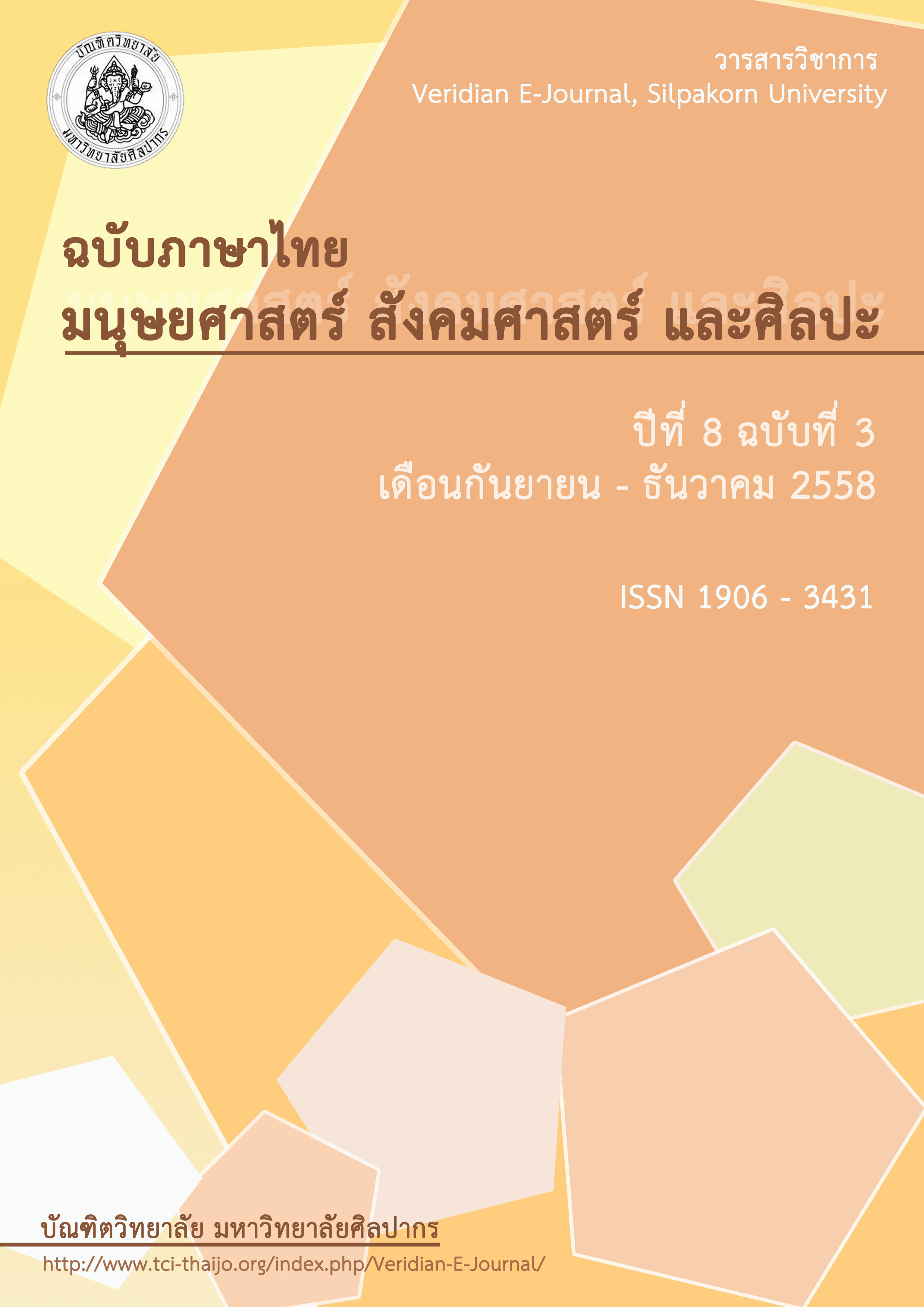พฤติกรรมของผู้บริโภคในกรุงเทพมหานครในการใช้โทรศัพท์สมาร์ทโฟน เพื่อการระบุตำแหน่งตนเอง
Main Article Content
บทคัดย่อ
การวิจัยนี้มีวัตถุประสงค์เพื่อศึกษาพฤติกรรมของผู้บริโภคในกรุงเทพมหานครในการใช้โทรศัพท์สมาร์ทโฟนเพื่อการระบุตำแหน่งตนเอง การศึกษาเก็บรวบรวมข้อมูลโดยใช้แบบสอบถามออนไลน์ จากผู้บริโภค ที่พักอาศัยอยู่ในเขตกรุงเทพมหานคร ที่เคยใช้โทรศัพท์สมาร์ทโฟนเพื่อการระบุตำแหน่งตนเอง (Check-in) จำนวน 300 ตัวอย่าง แล้วนำข้อมูลมาวิเคราะห์โดยใช้สถิติเชิงพรรณนา ได้แก่ ค่าความถี่ ร้อยละ และค่าเฉลี่ย
ผลการศึกษาพบว่า ผู้ตอบแบบสอบถาม ส่วนใหญ่เป็นเพศหญิง อายุระหว่าง 25 – 35 ปี สถานภาพโสด ระดับการศึกษาสูงสุดคือ ระดับปริญญาตรี อาชีพพนักงานบริษัทเอกชน/ห้างร้าน มีรายได้ส่วนตัวเฉลี่ยต่อเดือน 30,001 – 50,000 บาท ส่วนใหญ่พักอาศัยในเขตกรุงเทพมหานคร พื้นที่กลุ่มกรุงเทพใต้ (เขตปทุมวัน เขตบางรัก เขตสาทร เขตบางคอแหลม เขตยานนาวา เขตคลองเตย เขตวัฒนา เขตพระโขนง เขตสวนหลวง และเขตบางนา)
สำหรับพฤติกรรมการใช้โทรศัพท์สมาร์ทโฟนเพื่อการระบุตำแหน่งตนเอง (Check-in) พบว่า ผู้ตอบแบบสอบถามส่วนใหญ่รู้จัก และใช้งานโทรศัพท์สมาร์ทโฟนเพื่อการระบุตำแหน่งตนเอง (Check-in) โดยมีระยะเวลาใช้งานมากกว่า 3 ปี ขึ้นไป แอพพลิเคชั่น Facebook เป็นแอพพลิเคชั่นที่ติดตั้ง และใช้งานบ่อยที่สุด หากจะเปลี่ยนไปติดตั้ง และใช้งานแอพพลิเคชั่นอื่น มีเหตุผลเพราะแอพพลิเคชั่นที่ใช้อยู่ในปัจจุบันมีความยุ่งยากในการใช้งาน/ซับซ้อน นอกจากนี้พบว่าผู้ตอบแบบสอบถามส่วนใหญ่ใช้อินเทอร์เน็ตประเภทแพ็กเกจรายเดือน แบบไม่จำกัดการใช้งาน และมีเหตุผลหลักในการใช้โทรศัพท์สมาร์ทโฟนเพื่อการระบุตำแหน่งตนเอง (Check-in) คือ เติมเต็มการใช้ชีวิตกับเครือข่ายสังคมปัจจุบัน โดยมีเหตุผลย่อยคือ เพื่อดูเพื่อน/สมาชิกในครอบครัว กำลังอยู่สถานที่ใด ณ เวลาขณะนั้น และส่วนใหญ่ไม่เคยระบุตำแหน่งตนเอง (Check-in) ในตำแหน่งที่ไม่ใช่ตำแหน่งจริงหรือสถานที่จริง สำหรับผู้ที่มีอิทธิพลในการตัดสินใจใช้คือ ตัวเอง โดยส่วนใหญ่ใช้ในช่วงเวลาบ่าย/เย็น (13.01น. – 18.00 น.) สถานที่ใช้บ่อยที่สุดคือ ร้านค้า/ร้านอาหาร และมีความถี่ในการใช้มากที่สุด 1 – 3 ครั้งต่อวัน
ผลการศึกษา ด้านปัจจัยที่มีผลต่อการตัดสินใจใช้โทรศัพท์สมาร์ทโฟนเพื่อการระบุตำแหน่งตนเอง (Check-in) พบว่า ผู้ตอบแบบสอบถามส่วนใหญ่ให้ความสำคัญต่อปัจจัยที่มีผลต่อการตัดสินใจในระดับมาก ในด้านความเข้ากันได้กับสิ่งที่มีอยู่ ความง่ายในการใช้งาน ความสามารถในการสังเกตได้ ความสามารถในการทดลองได้ ตามลำดับ และให้ความสำคัญต่อปัจจัยที่มีผลต่อการตัดสินใจในระดับปานกลาง ในคุณประโยชน์ที่ได้รับ นอกจากนี้ยังพบว่าผู้ที่มีอายุต่างกันมีพฤติกรรมการใช้ที่ไม่แตกต่างกันมากนัก แต่ผู้ที่มีรายได้ส่วนตัวเฉลี่ยต่อเดือนแตกต่างกันมีพฤติกรรมในการใช้โทรศัพท์สมาร์ทโฟนเพื่อการระบุตำแหน่งตนเอง (Check-in) ที่ต่างกัน โดยเฉพาะในด้านเหตุผลในการใช้ สถานที่ใช้งาน และความถี่ในการใช้
AbstractThis research aimed to investigate behavior of consumers in Bangkok towards using smartphones for check-in. Data collection was done by the use of online questionnaires distributed to 300 consumers in Bangkok who used smartphone for check-in. Data obtained were, then, analyzed by the use of descriptive statistics, consisting of frequency, percentage and mean.
The findings presented that most respondents were single female in the age of 25 – 35 years old with Bachelor’s degree. They worked as employee of private company/shop and earned average monthly income at the amount of 30,001 – 50,000 Baht. Most of them lived in the South of Bangkok (including Phatumwan, Bang Rak, Sathorn, Bang Kor Laem, Yannawa, Klong Toei, Wattana, Pra Kanong, Suan Luang and Bang Na districts).
Regarding the behavior of using smartphones for check-in, most respondents had been acquainted with and used it for more than 3 years. Facebook was the most favorite application that they mostly installed and frequently used. If they happened to install and use other applications for check-in, they did it because of the complexity of the existing one. The majority subscribed for the monthly unlimited internet package. The main reason of using smartphone for check-in was to fulfill life in the social network; while the minor reason was to get to know where friends/family members were staying at the certain moment. The majority had never checked-in at the false location or untrue place. Person influencing them to decide to use the check-in application was the respondents themselves. They mostly used the check-in application in the afternoon/evening (13.01 – 18.00 hrs.). The place where they mostly checked-in was shop/restaurant. The most frequency of using smartphone for check-in was 1 – 3 times per day.
The finding on factors affecting consumers towards using smartphones for check-in indicated that most respondents ranked high level of importance to compatibility, complexity, observability, and trial-ability factors, respectively; but ranked moderate level of importance to relative advantage factor. In addition, the research found that different groups of age shared the similar behavior in using smartphones for check-in but different average ranges of personal monthly income have different behavior in using smartphones for check-in, particularly reason of use, place of use and frequency of use.
